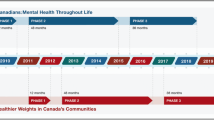Abstract
Improving community health “from the ground up” entails a comprehensive ecological approach, deep involvement of community-based entities, and addressing social determinants of population health status. Although the Centers for Disease Control and Prevention, the Office of the Surgeon General, and other authorities have called for public health to be an “inter-sector” enterprise, few models have surfaced that feature local health departments as a key part of the collaborative model for effecting community-level change. This paper presents evaluation findings and lessons learned from the Partnership for the Public’s Health (PPH), a comprehensive community initiative that featured a central role for local health departments with their community partners. Funded by The California Endowment, PPH provided technical and financial resources to 39 community partnerships in 14 local health department jurisdictions in California to promote community and health department capacity building and community-level policy and systems change designed to produce long-term improvements in population health. The evaluation used multiple data sources to create progress ratings for each partnership in five goal areas related to capacity building, community health improvement programs, and policy and systems change. Overall results were generally positive; in particular, of the 37 partnerships funded continuously throughout the 5 years of the initiative, between 25% and 40% were able to make a high level of progress in each of the Initiative’s five goal areas. Factors associated with partnership success were also identified by local evaluators. These results showed that health departments able to work effectively with community groups had strong, committed leaders who used creative financing mechanisms, inclusive planning processes, organizational changes, and open communication to promote collaboration with the communities they served.
Similar content being viewed by others
References
The National Community Care Network Demonstration Program, (CCN). Hospital Research and Educational Trust; April 1995.
Cheadle A, Senter S, Procello A, et al. The California wellness foundation’s health improvement initiative: evaluation findings and lessons learned. Am J Health Prom. 2005;19(4):286–296.
California Endowment. Work in Health Initiative. January 2000.
The Colorado Trust. Partnerships for Health Initiative; 2005–2013.
Wallerstein N. Power between evaluator and community research relationships within New Mexico’s healthier communities. Soc Sci Med. 1999;00:1–15.
Enhancing Community Capacity. California Healthy Cities and Communities Annual Conference, Center for Civic Partnership, San Diego, California; April 2000.
El-Askari G, Freestone J, Irizarry C, et al. The healthy neighborhoods project: a local health department’s role in catalyzing community development. Health Educ Behav. 1998;25(2):146–159.
Anderson LM, Scrimshaw SC, Fullilove MT, Fielding JE, and the Task Force on Community Preventative Services. The community guide’s model for linking the social environment to health. Am J Prev Med. 2003;24(3S):12–20.
Alter C, Hage J. Organizations Working Together. Newbury Park, CA: Sage; 1993.
Butterfoss FD, Goodman RM, Wandersman A. Community coalitions for prevention and health promotion. Health Educ Res. 1993;8:315–330.
Chavis DM. The paradoxes and promise of community coalitions. Am J Comm Psych. 2001;29(2):309–320.
Lasker RD, Committee on Medicine and Public Health. Medicine and Public Health: The Power of Collaboration. Chicago: Health Administration Press; 1997.
The National Association of County and City Health Officials. The Community Public Health System Improvement Plan: A Blueprint for Transformation. The Turning Point Initiative, sponsored by the W.K. Kellogg and Robert Wood Johnson Foundations.
The National Association of County and City Health Officials. A Strategic Approach to Community Health Improvement: MAPP Field Guide. National Association of City and County Health Officials; 2007.
COMMIT Research Group. Community intervention trial for smoking cessation (COMMIT): I. Cohort results from a four-year community intervention. Am J Pub Health. 1995;85(2):183–192.
Wagner EH, Wickizer TM, Cheadle A, et al. The community health promotion grants program in the West II: Changes in attitudes, environments and behaviors. Health Serv Res. 2000;35(3):561–589.
Shortell SM, Zukoski AP, Alexander JA, et al. Evaluating partnerships for community health improvement: tracking the footprints. J Health Polit Policy Law. 2002;27(1):49–91.
Mitchell SM, Shortell SM. The governance and management of effective community health partnerships: a typology for research, policy, and practice. Milbank Quarterly. 2000;78(1):241–290.
Roussos TS, Fawcett SB. A review of collaborative partnerships as a strategy for improving community health. Ann Rev Pub Health. 2000;21:369–402.
Metzler MM, Higgins DL, Beeker CG, et al. Addressing urban health in Detroit, New York City, and Seattle through community-based participatory research partnerships. Am J Pub Health. 2003;93:803–811.
Green L, Daniel M, Novick L. Partnerships and coalitions for community-based research. Pub Health Rep. 2001;116(supplement):20–31.
Galea S, Factor SH, Foley M, et al. Collaboration among community members, local health service providers, and researchers in an urban research center in Harlem, New York. Public Health Reports. 2001;116:530–539.
Lasker R, Weiss ES. Broadening participation in community problem solving: a multidisciplinary model to support collaborative practice and research. J Urban Health. 2003;80(1):14–60.
Schulz AJ, Israel BA, Lantz P. Instrument for evaluating dimensions of group dynamics within community-based participatory research partnerships. Eval Program Plann. 2003;26:249–262.
Author information
Authors and Affiliations
Corresponding author
Additional information
Cheadle is with the Department of Health Services, University of Washington, Seattle, WA, USA; Hsu, Pearson, and Beery are with the Center for Community Health and Evaluation, Seattle, WA, USA; Schwartz is with the Kaiser Foundation Health Plan and Hospitals, Oakland, CA, USA; Greenwald is with the School of Policy, Planning, and Development, University of Southern California, Los Angeles, CA, USA; Flores is with the The California Endowment, San Francisco, CA, USA; Casey is with the Partnership for the Public’s Health, Oakland, CA, USA.
Rights and permissions
About this article
Cite this article
Cheadle, A., Hsu, C., Schwartz, P.M. et al. Involving Local Health Departments in Community Health Partnerships: Evaluation Results from the Partnership for the Public’s Health Initiative. J Urban Health 85, 162–177 (2008). https://doi.org/10.1007/s11524-008-9260-4
Received:
Accepted:
Published:
Issue Date:
DOI: https://doi.org/10.1007/s11524-008-9260-4




